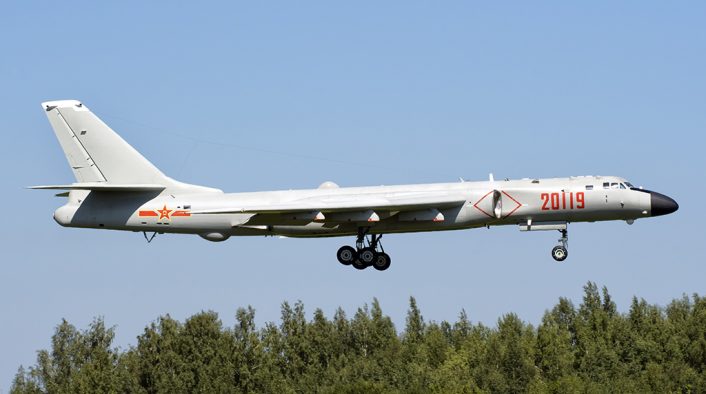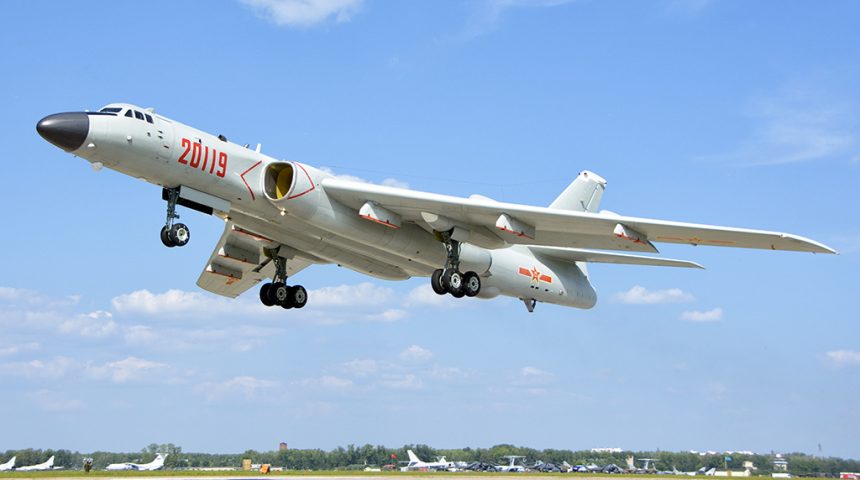Unsurprisingly, the package of 13 Chinese combat aircraft, (including eight H-6 bombers) entering Taiwan’s ADIZ last Saturday were carrying out a mock attack on USS Theodore Roosevelt.
As already reported in detail, a total of 28 aircraft, including as many as eight PLAAF (People’s Liberation Army Air Force) H-6 bombers, “intruded” into Taiwan’s ADIZ (Air Defense Identification Zone) between Jan. 23 and 24, 2021.
In particular, we noticed that the mission on Saturday Jan. 23, was conducted as the Theodore Roosevelt Carrier Strike Group (TRCSG), led by USS Theodore Roosevelt aircraft carrier entered the South China Sea (SCS) “to conduct routine operations”.
At this respect, here’s the comment this Author made in a previous story on the spike in PLA activity near Taiwan as the U.S. flattop entered the same area of operations: “The simultaneous presence of the Chinese Xian H-6K in the region as the TRSG entered the SCS is particularly interesting, if we consider the role of the PLAAF bomber. The H-6K is a highly modified variant from the original H-6 bomber (itself a Tu-16 derivative), designed for long-range/stand-off maritime or land strike capability with long-range anti-ship and land-attack cruise missiles. In short, it is capable of attacking U.S. carrier battle groups or other priority targets with up to six YJ-12 ASCM (Anti-Ship Cruise Missiles) and 6/7 KD-20 ALCMs.”
Dealing with the YJ-12, it has a range of 400 km, can reach speeds of up to Mach 3, and is capable of performing airborne evasive maneuvers approaching the target: these features make this ASCM (Anti-Ship Cruise Missile) difficult for Aegis Combat Systems and SM-2 surface-to-air missiles that protect U.S. carrier strike groups.
A confirmation that the mission flown on Jan. 23 was simulating an air strike on the U.S. aircraft carrier comes from the Financial Times, that on Jan. 29, 2020 reported: “People familiar with intelligence collected by the US and its allies said the bombers and some of the fighter aircraft involved were conducting an exercise that used a group of US Navy vessels led by the carrier USS Theodore Roosevelt in the same area as a simulated target. Pilots of H-6 bombers could be heard in cockpit conversations confirming orders for the simulated targeting and release of anti-ship missiles against the carrier, the people said.”
One #PLAN #Y8Q(maybe based at Dachang), eight #H6K(maybe based at Leiyang), and four #J16(maybe based at Xiangtang) entered Taiwan’s ADIZ on Jan. 23.
Maybe they came for USS Theodore Roosevelt (CVN-71)
Image:©MND R.O.C., ©PlanetLabs, ©GoogleEarth https://t.co/QPqEcEgfYk pic.twitter.com/ccGWswiha9
— August (@August20190831) January 24, 2021
While not reported to be part of the mission last week, it’s worth mentioning that the People’s Liberation Army Air Force‘s has also developed a further variant of the H-6K, designated H-6N which was specifically designed as a ballistic missile launcher. Its primary weapon should be the CH-AS-X-13, also known as DF-21D, the air launched version of the DF-21 “Carrier Killer” Anti-Ship Ballistic Missile (AShBM), reportedly with a range of 1450 km (780 NM), Mach 6 speed (some sources state even Mach-10) and a 600 kg (about 1300 lbs) payload.
Here’s what we wrote about the DF-21 in a previous article:
“The first reports about the existence of the DF-21D in 2010 sparked some concerns as Pentagon officials stated that, if the claims about the missile’s capabilities are true, the United States may not have a defense against it, as the maneuverable re-entry vehicle (MaRV) and the high speed could complicate the interception by air defense weapons. This led the U.S. Navy to potentiate the Aegis Ballistic Missile Defense System aboard ships in the Pacific Ocean while new advanced systems are developed. China reportedly test-fired two AShBM in the South China Sea in late August, one of them being a DF-21D.”

Along with the H-6K/N, the Su-30 (and according to some sources also the J-16) multirole aircraft are able to carry out maritime strike missions using the Kh-31P and the YJ-91A anti-ship missiles.
The YJ-91, in particular, is an indigenous development of the Russian Kh-31P anti-radar missile. The YJ-91A (one of the two variants of the missile, the other one being an anti-radiation missile for SEAD missions), with sea-skimming capability: it cruises at no more than 20 metre above sea level and drops to lower altitude (7 metre) at the terminal stage. This attack altitude can be further reduced to just 1.2 metre above sea level, when the sea state allows. Its estimated range is about 50 km (31 miles). According to the book “Modern Chinese Warplanes” by Andreas Rupprecht, as an alternative to the YJ-91, Naval Aviation uses also the Russian original Kh-31P, which was acquired as part of the Su-30MKK’s weapons package.
By the way, the missions like the one flown by the Chinese H-6s are done by Russia, U.S. and NATO forces, regularly. “Train as you fight, fight as you train”.
H/T Ryan Chan for the heads up!









